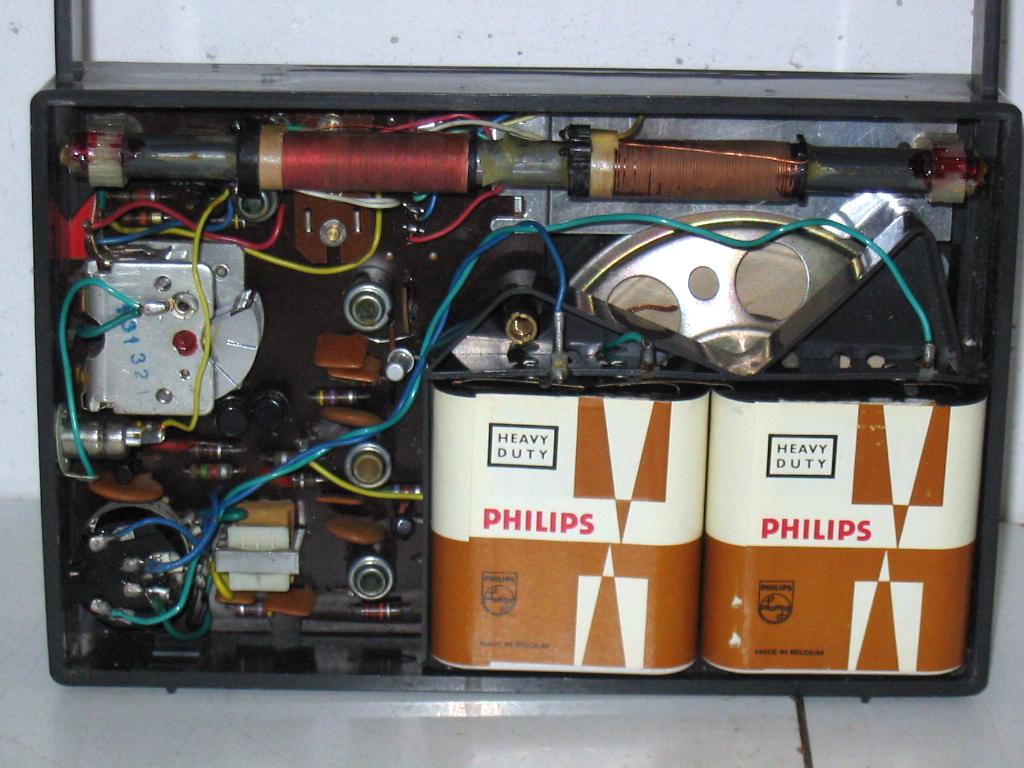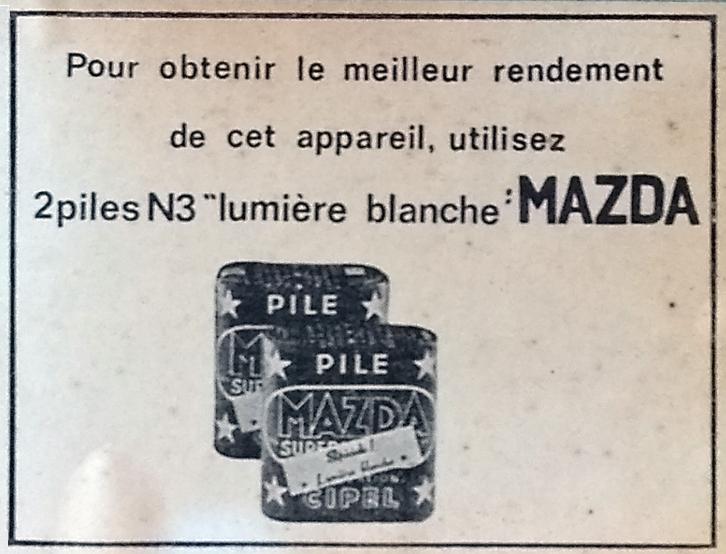
270
Item nr.

Clarville PP8 Portable
Youth memory.
Data for Clarville PP8
| Production | France, 1962.
Price was FF159. |
|---|
| Bands | LW, MW. |
|---|
| Cabinet | Plastic.
Size 22x14x5.5 cm.
Weight 900 gr. |
|---|
| Power | Batt 2x4.5V (or 9V), 10-15mA. |
|---|
| Documents | Schema (from inside sticker), DocTSF, Rmorg, Ad, Slide deck. |
|---|
The Design
My very first radio, an old portable I got from my parents around 1971, looked very much like this one. It isn't the same though, my radio was blue (and I don't remember the inscriptions). RadioMuseum mentions Clarville as an export brand for Arel. The radios were actually produced by Sonolor.
 The French design is clearly recognizable, for example from the antenna plug and the use of flat 4.5V batteries. Those batteries were very popular in France; there was a special term Lampe de poche for flash lights with this type, while une torche meant a cylindrical lamp with C or D batteries. This radio also uses the center voltage of the two batteries, as you can see from the schema, which makes it a challenge to supply the radio from a 9V battery or adapter. While the use of wavelength-linear tuning capacitors was common, this tuning cap looks rather circular so it is closer to capacity-linear. Perhaps this was to save space. I computed the dial layout for capacity linear and wavelength linear tuning, and found that the capacity linear model is closest to the actual tuning.
The French design is clearly recognizable, for example from the antenna plug and the use of flat 4.5V batteries. Those batteries were very popular in France; there was a special term Lampe de poche for flash lights with this type, while une torche meant a cylindrical lamp with C or D batteries. This radio also uses the center voltage of the two batteries, as you can see from the schema, which makes it a challenge to supply the radio from a 9V battery or adapter. While the use of wavelength-linear tuning capacitors was common, this tuning cap looks rather circular so it is closer to capacity-linear. Perhaps this was to save space. I computed the dial layout for capacity linear and wavelength linear tuning, and found that the capacity linear model is closest to the actual tuning.
The dial markings for MW (PO in French) are just numerals, to be read as x100kHz, while the Long Wave (GO) has no numbers but just four station names. Of the four stations listed on the LW dial, three were still operational in 2020: France1 on 162kHz carries no sound but still transmits time signals, BBC still works but now on 198kHz, and RTL Luxemburg on 234kHz was still crystal clear all over Western Europe. In 2025, RTL was also gone.
| Obtained | 2/2006
from Karin Lampen; sn=0656751. |
|---|
| Condition | 8; crack in dial, otherwise neat and complete. Modified for 9V battery. |
|---|
| Value (est.) | 10€. |
|---|
| Sound sample | PLAY SOUND French song: in your nose there is a little hole. |
|---|
This Object
 Inside picture, showing the (empty) Philips batteries that were inside when I got the radio. The battery compartment has only three contacts. The long stripe of one battery must be folded over to share the contact with the short strip of the other one.
Inside picture, showing the (empty) Philips batteries that were inside when I got the radio. The battery compartment has only three contacts. The long stripe of one battery must be folded over to share the contact with the short strip of the other one.  The use of flat 4.5V batteries (type 3R12) is a bit problematic because the get harder to obtain, and are quite expensive. The PP8 connects the speaker to the center of the power supply, but appearently, this connection is not supposed to carry DC. So I connected a capacitor (of 470uF) between the center and plus connector, and now the radio plays fine on a 9V block battery.
The use of flat 4.5V batteries (type 3R12) is a bit problematic because the get harder to obtain, and are quite expensive. The PP8 connects the speaker to the center of the power supply, but appearently, this connection is not supposed to carry DC. So I connected a capacitor (of 470uF) between the center and plus connector, and now the radio plays fine on a 9V block battery.
Part of Gerard's Radio Corner.
Generated by SiteBuilder on
6/9/2025
by Gerard
 The French design is clearly recognizable, for example from the antenna plug and the use of flat 4.5V batteries. Those batteries were very popular in France; there was a special term Lampe de poche for flash lights with this type, while une torche meant a cylindrical lamp with C or D batteries. This radio also uses the center voltage of the two batteries, as you can see from the schema, which makes it a challenge to supply the radio from a 9V battery or adapter. While the use of wavelength-linear tuning capacitors was common, this tuning cap looks rather circular so it is closer to capacity-linear. Perhaps this was to save space. I computed the dial layout for capacity linear and wavelength linear tuning, and found that the capacity linear model is closest to the actual tuning.
The French design is clearly recognizable, for example from the antenna plug and the use of flat 4.5V batteries. Those batteries were very popular in France; there was a special term Lampe de poche for flash lights with this type, while une torche meant a cylindrical lamp with C or D batteries. This radio also uses the center voltage of the two batteries, as you can see from the schema, which makes it a challenge to supply the radio from a 9V battery or adapter. While the use of wavelength-linear tuning capacitors was common, this tuning cap looks rather circular so it is closer to capacity-linear. Perhaps this was to save space. I computed the dial layout for capacity linear and wavelength linear tuning, and found that the capacity linear model is closest to the actual tuning.

 Inside picture, showing the (empty) Philips batteries that were inside when I got the radio. The battery compartment has only three contacts. The long stripe of one battery must be folded over to share the contact with the short strip of the other one.
Inside picture, showing the (empty) Philips batteries that were inside when I got the radio. The battery compartment has only three contacts. The long stripe of one battery must be folded over to share the contact with the short strip of the other one.  The use of flat 4.5V batteries (type 3R12) is a bit problematic because the get harder to obtain, and are quite expensive. The PP8 connects the speaker to the center of the power supply, but appearently, this connection is not supposed to carry DC. So I connected a capacitor (of 470uF) between the center and plus connector, and now the radio plays fine on a 9V block battery.
The use of flat 4.5V batteries (type 3R12) is a bit problematic because the get harder to obtain, and are quite expensive. The PP8 connects the speaker to the center of the power supply, but appearently, this connection is not supposed to carry DC. So I connected a capacitor (of 470uF) between the center and plus connector, and now the radio plays fine on a 9V block battery.